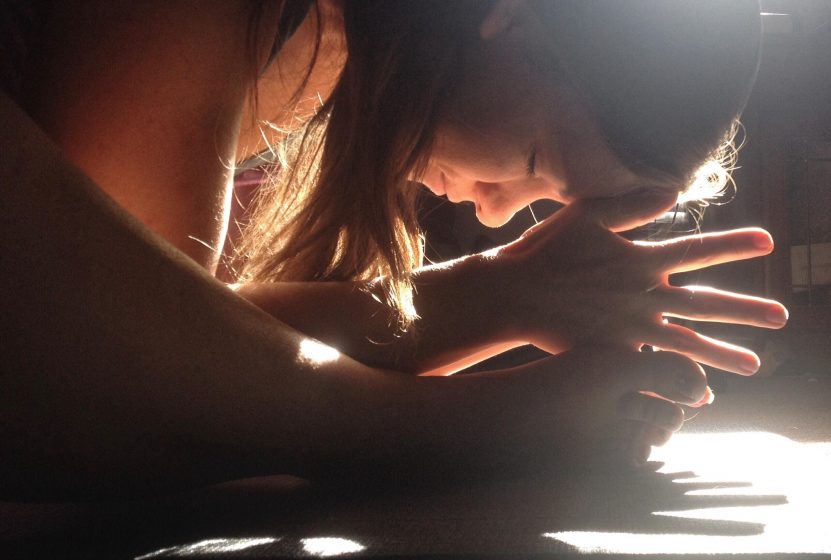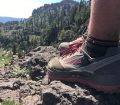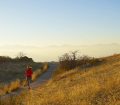If you follow any of your favorite trail and ultra runners on social media these days, you may have noticed a trending toward bending. Elite runners Emelie Forsberg and Anna Frost have gone so far as to certify as yoga instructors themselves, and it seems more runners are being drawn to the practice with every passing year. There are, however a good portion of people who have an automatic eye roll reserved for “any of that goofy new aged hippie circus stuff.“ In Western culture we tend hear yoga, and immediately think of either incense and chanting, or impossibly pretzeled bodies. The circus tricks make for high traffic on Instagram feeds. They are however, a tiny glimpse of what the actual practice of yoga can lead to. So what are some of the real-life benefits of yoga practice? And how can it benefit us as runners? As one with quite a few years of experience and a yoga teaching certification, I can tell you there is far more than flexibility in store.
Respiratory Conditioning
As in yoga, let’s begin with the breath. It’s an easy admission to say that none of us is getting anywhere without proper oxygenation. Ask any asthma sufferer how important breath is. Maybe as athletes, we take breathing for granted sometimes. But as we push our bodies to greater limits, breath efficiency becomes a big deal. Shout out to your genetically-blessed physical prowess if you have never experienced that moment in a run where your lungs burn and you are raggedly gasping, but your tired leg muscles can’t seem to get oxygen fast enough. In the ultra world, we’re all quick to admire Kilian Jornet for his impressive VO2 Max. It makes a difference, this breath, and the way our bodies make use of it.
In asana- the physical portion of yoga, movements are coordinated with elongated deep breathing. This regular practice of slowing the breath, to maximize breath efficiency and increase lung capacity becomes a distinct advantage of yoga practice. In a 2001 Indian study*, the VO2 Max of subjects who adopted a regular daily yoga practice was shown to increase significantly. Long-term benefits, such as VO2 Max, come with regular practice, but a calmer central nervous system and overall feeling of well being can often be seen immediately.
Let’s be honest, most likely, none of us are going to yoga our way to Killian status, but better pulmonary efficiency can certainly give us a leg up in trying.
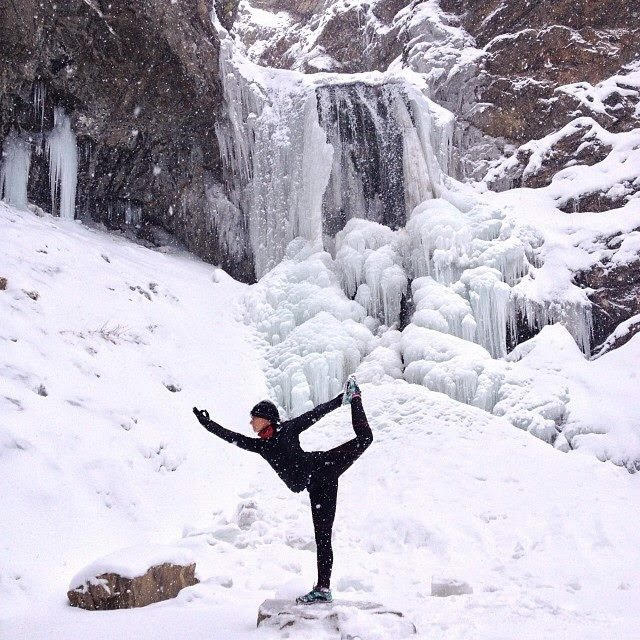
Stability and Joint Health
As runners, we are constantly having our attention drawn to one joint or another. Many a long time runner has ended up in physical therapy, or surgery, or both, often for knees and hips. Not to mention all of the nagging pains we try to ignore in our toes, arches, ankles, SI joints, and low backs. And since we’re mountain climbing, long distance warriors, we probably shouldn’t exclude shoulders and other odd arm joints. Let’s just say all the joints. They are prone to injury and ailment.
If you aren’t familiar with regular yoga practice, you might be wondering what stretching and relaxation breathing can possibly to for your messed up hip. Our Western idea of yoga is sometimes sorely limited to the bendy and flexible. A huge revelation occurred to me over the course of rehabilitating several traumatic injuries over the past few years: I was floppy. I had always seen my natural flexibility as an advantage, but in running footage I began to notice how I sank into my hips and rolled into my arches as I ran. Hip problems had plagued me for years, and despite regular running, chiropractic care and weightlifting, joint injuries were a common occurrence for me. Once I graduated from physical therapy… again, I reinvested myself in yoga. It was in class very shortly thereafter that my instructors words struck a chord in my brain. “Stability comes before Flexibility”. What?! This had been my problem all along! Loose joints with imbalanced strength were making my flexibility a liability. My focus shifted, and each pose became a quest for stability. I made a goal to build strength from the ground up. Having stronger foot arches and greater ankle stability has set the foundation for health and alignment in all of my joints. Shifting the focus of poses from gaining flexibility to building stability meant more effort. In even the simplest pose of my practice, I put effort into isometric contraction, and a focus on energetically gathering support around the joints. As I did this consistently and with proper alignment, I gained strength specific to each joint girdle. On a recent trip to my favorite chiropractor, he was shocked that my SI joint that had been a regular issue, did not need any attention. My running form has improved, and the hip pain that has plagued me for years is generally no longer an issue. Yoga practice, by nature, brings space and blood flow to the joints, can encourage cartilage health, and slow degeneration. In a 2011 study**, long-term yoga practitioners were shown to have significantly less cartilage degeneration than non-yogis. So just maybe, if we can bring more runners onto the mat, we can have fewer runners under the knife, and a lot more pain-free runners on the trails for a lot more years to come.
Proprioception and Injury Prevention
Proprioception may be one of my favorite words of the day. It essentially means awareness and control of where your body is in space. The rocks and roots of trail running make good proprioception a necessity unless you like landing on your face with the grace of a baby giraffe. So what is the best way to become aware of our body parts during movement? We slow movement down, pay attention, and practice. That’s yoga. The attention to muscular energy that is required in yoga increases body awareness. I don’t need a study to tell me this, just years of my own experiences with poses that I can now do with my eyes closed. It doesn’t take a genius to make the connection between body awareness and injury prevention, but the yoga advantage in injury prevention goes further than just knowing where to place your foot and where to swing your arm to keep your balance. It also comes in reaction time, and strength plus elasticity of muscles and ligaments. Maybe you didn’t see that sinister ankle-roller root in the trail, but your Warrior 2s and Triangle poses have prepared you for this moment, and your strong core can keep you upright, and your foot, ankle, and lower leg tissues can pull you right out of the roll without damage.
Flexibility
Maybe this part goes without saying, but I’d like to touch on the flexibility aspect of yoga. This is an aspect that keeps many a runner with tight hamstrings off the mat and out of the studio. Before I talk about how yoga makes us flexible, I want to discuss the big, scary, seemingly impossible leap from head and shoulders to knees and toes. Flexibility isn’t the focus of yoga, but let’s call it a happy side effect. All of the other benefits of a regular yoga practice are attainable to even the least flexible among us through pose modification. If your inner competitive athlete just cringed at the thought of not being flexible enough to “do the pose right,” take heart. My own favorite yoga instructor likes to say that we must specify the pose to our individual needs. Alignment takes a priority over results. “No pain, no gain” doesn’t apply here.
Picture if you will, our friend Dave. He’s brought his awesome hill-climbing hamstrings to yoga class, but while the dancer in the corner stands in a forward fold with her hands flat on the floor and her nose between her knees, Dave’s rounded back and shoulders keep his breath short and strained, as his fingers dangle about the level of his knees. His back hurts, his hammies are grabbing in a terrified manner, and Prana is the last thing on his mind. Luckily, Dave’s excellent instructor is aware or his struggle. He is instructed to bend his knees and turn his “sit bones” upward, to lengthen the spine and chest forward, placing his hands on blocks or his thighs. This allows his spinal curve to correct to its natural position, he can properly lengthen his hamstrings this way, without danger of injury, and now he feels like a rock star. This is Dave’s ideal forward fold for the moment. Release will come with time and practice, and Dave’s hammies will be more awesome than ever. In the meantime, he remains injury-free as he enjoys all the benefits of a healthy yoga practice. When flexibility does come, it comes with strength and alignment as it’s gatekeepers.
If this last paragraph has left you wondering about the ‘how and why’ of flexibility, let’s talk a little bit about what makes us flexible. Your muscles are plenty long enough to stretch the necessary length for proper function with the bones around them. We think of our muscles as being “too short” or “too tight”, but a huge factor in this feeling isn’t the muscle itself, but Fascia. This web-like fibrous connective tissue gets ignored a lot. It runs throughout your entire body, supporting your organs, muscles, tendons, circulatory system, digestive system, nerves, pretty much everything. Muscle fascia is generally smooth and elastic, but the unhealthy patterns we develop in the way we hold our bodies regularly can create adhesion and distortions, restricting blood flow and cause nerve pain. We all have them. Hunched posture, runner’s knee, plantar fasciitis, and IT band syndrome are just a few familiar issues that can be caused by fascia distortions. Moving through yoga poses helps to hydrate the fascia and free up the fascia layers. Is yoga the end-all, be-all for myofascial release? No. Deep tissue massage is invaluable for fascia health. But yoga practice is excellent maintenance work for keeping the fascia from reforming in unhealthy patterns, undoing what your massage therapist has done for you. Yoga makes for healthy new fascia patterns going forward.
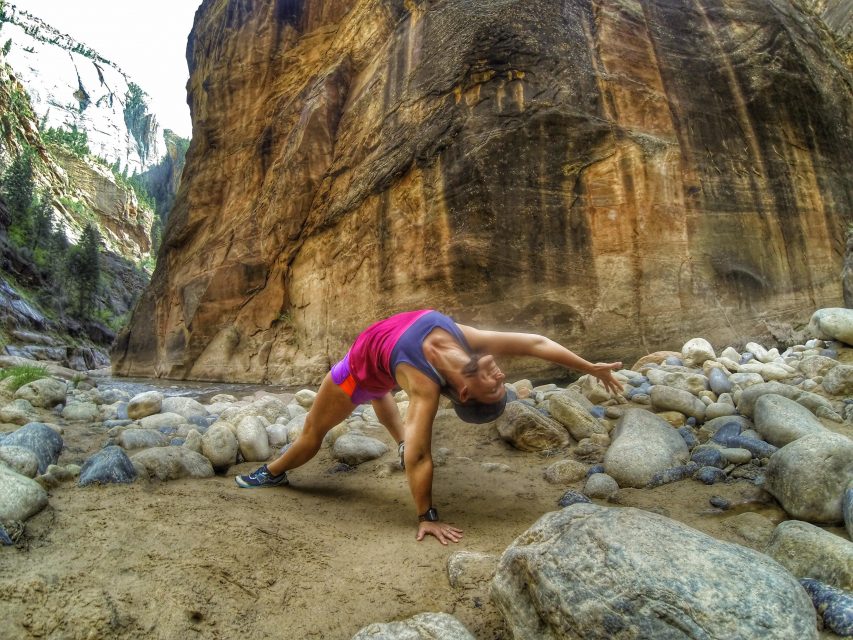
The Most Important Benefit
In my opinion, the most impactful benefit of yoga practice to a runner is arguably the most simple: Attention to individual need. In the naturally competitive world of running, it’s awfully common that we watch the elites, copy what we see, and then wonder why we aren’t… well, elite. But if you have ever crewed an aid station or sat at a finish line, watching the speedsters come in, you’ll have noticed each one of them runs to his or her strength. Sage may float like a gazelle, his form so refined as to make Jim’s wild abandon look a little comical…. if Jim didn’t have a 15 minute lead on him. One runner may thrive on a strict vegan diet, while another struggles terribly, feeling fully energized when he goes Paleo. Yoga practice helps us shift perspective. A regular practice encourages an attentive individual mindset. Yoga bring us to meet with ourselves each day on the mat, ask, “What do I need?” and then encourages us to notice the answers that are right there if we pay attention. That attention can both heal and prevent injury.
It would take weeks for me to list all of the ways that yoga has benefited me on and off the trails. Even just incorporating a little bit of yoga practice into your routine can make a difference. If you haven’t yet considered adding yoga to your cross-training, I hope that you can take a moment to consider what it might do for you. With so many benefits to a regular yoga practice, it’s no wonder that mindful runners everywhere are flocking to their yoga mats. For injury prevention, postural correction, quicker recovery, better efficiency, and overall health, yoga just might be your next vehicle on the road to healthier running and general awesomeness, on the trails and in everyday life.
*https://www.ncbi.nlm.nih.gov/m/pubmed/12040766/
**https://www.ncbi.nlm.nih.gov/m/pubmed/20711844/?i=4&from=yoga%20and%20cartilage



